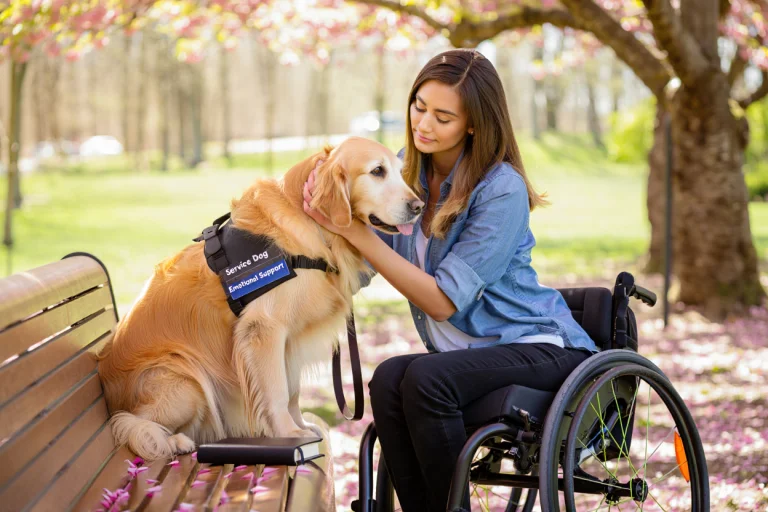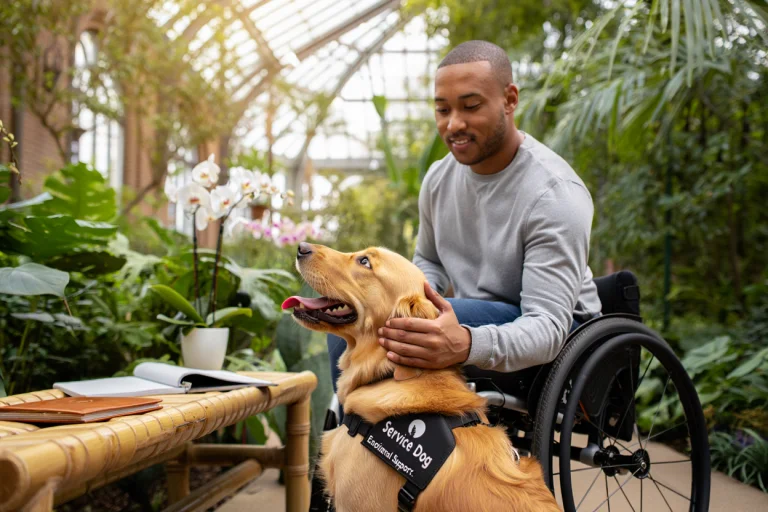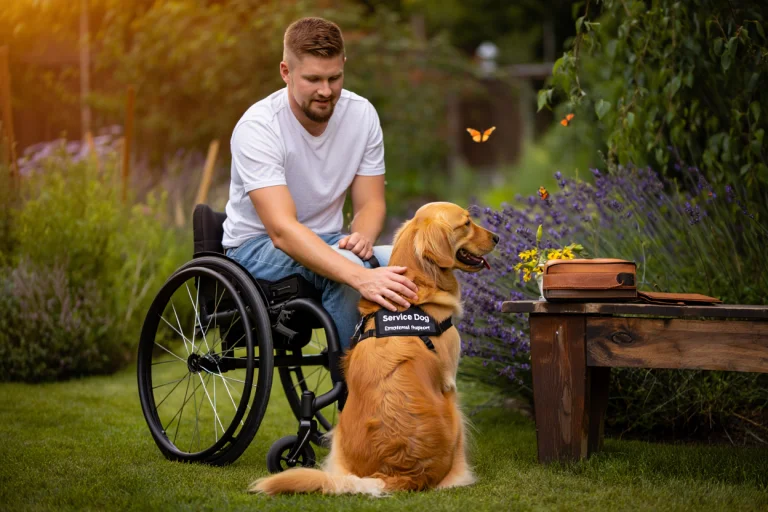Discover how American service pets provide crucial assistance for disabilities through mobility support, medical alerts, psychiatric help, and more in this comprehensive guide.

Table of Contents
Service animals have transformed countless lives across America, providing essential assistance to individuals with disabilities and health conditions. American service pets are specially trained companions that perform specific tasks for their handlers, enabling greater independence and improved quality of life. These remarkable animals go far beyond the role of beloved pets – they become lifelines, offering physical support, emotional stability, and crucial interventions that allow people with disabilities to navigate daily challenges with confidence. In this comprehensive guide, we’ll explore six significant ways American service pets can enhance your life and provide valuable support for various needs.
What Are American Service Pets?
Before diving into the benefits, it’s important to understand what qualifies as a service animal under American law. The Americans with Disabilities Act (ADA) defines service animals as dogs that are individually trained to perform specific tasks for people with disabilities. In some cases, miniature horses may also qualify as service animals.
Service animals differ from emotional support animals (ESAs) and therapy animals in terms of:
- Legal recognition: Service animals have protected access rights under federal law
- Training requirements: Service animals undergo extensive task-specific training
- Purpose: Service animals perform specific tasks related to a disability
Types of Service Animals
| Type | Primary Function | Common Breeds |
| Guide Dogs | Assist people with visual impairments | Labrador Retrievers, Golden Retrievers, German Shepherds |
| Hearing Dogs | Alert individuals with hearing impairments | Many breeds, often smaller to medium-sized dogs |
| Mobility Assistance Dogs | Help individuals with physical disabilities | Larger breeds like Labrador Retrievers, Golden Retrievers |
| Medical Alert Dogs | Detect medical emergencies | Various breeds with specialized training |
| Psychiatric Service Dogs | Support individuals with mental health conditions | Many breeds depending on specific tasks |
| Autism Service Dogs | Assist individuals with autism spectrum disorder | Often Labrador Retrievers, Golden Retrievers |
Now, let’s explore the six remarkable ways American service pets can provide life-changing assistance.

1. Physical Assistance and Mobility Support
How Service Dogs Transform Mobility
For individuals with physical disabilities or mobility impairments, service dogs can provide crucial physical assistance that enhances independence and reduces reliance on human caregivers or assistive devices.
Mobility service dogs are typically larger breeds with the strength and stability to provide physical support. These remarkable animals undergo specialized training to perform tasks such as:
- Retrieving objects: Picking up dropped items, fetching medications, or bringing needed supplies
- Opening doors: Operating door handles, automatic door buttons, and drawers
- Providing balance support: Offering stability while walking or standing
- Helping with transfers: Assisting with movement between wheelchairs, beds, and other surfaces
- Carrying items: Transporting small packages, groceries, or other necessities
According to a 2023 study published in the Journal of Disability Studies, individuals with mobility service dogs reported a 68% increase in their ability to complete daily tasks independently and a 47% reduction in reliance on personal care assistants.
Real-Life Impact
Sarah, a 34-year-old woman with multiple sclerosis, shares how her mobility service dog, Max, has transformed her life: “Before Max, I struggled to maintain my independence. Now, he helps me retrieve items I drop, opens doors when my hands aren’t cooperating, and provides balance support on days when walking is difficult. He’s given me back my freedom.”
2. Medical Detection and Alert Services
One of the most remarkable capabilities of American service pets is their ability to detect and alert to medical emergencies, often before the individual themselves is aware of the danger.
Seizure Response and Alert Dogs
Seizure response dogs are trained to assist during and after a seizure event by:
- Staying with their handler during a seizure
- Activating emergency response systems
- Fetching medications
- Providing physical support during recovery
Even more impressive are seizure alert dogs, which can detect subtle physiological changes before a seizure occurs, sometimes providing warnings 10-20 minutes before onset. This critical advance notice allows individuals to move to a safe location, take emergency medication, or notify someone nearby.
Diabetic Alert Dogs
Diabetic alert dogs can detect dangerous blood sugar fluctuations through scent, notifying their handlers of:
- Hypoglycemia (low blood sugar)
- Hyperglycemia (high blood sugar)
These alerts can prevent medical emergencies, especially during sleep when fluctuations might otherwise go unnoticed. A 2024 study in the American Diabetes Journal found that individuals with diabetic alert dogs experienced 70% fewer severe hypoglycemic episodes requiring medical intervention.
Allergy Detection Dogs
For those with severe allergies, specially trained dogs can detect even trace amounts of allergens like:
- Peanuts
- Tree nuts
- Gluten
- Dairy
These service dogs provide peace of mind for individuals and families managing life-threatening allergies, particularly for children in unpredictable environments.
3. Psychological and Psychiatric Support
American service pets provide invaluable assistance for individuals living with psychiatric disabilities and mental health conditions.
Psychiatric Service Dogs
Unlike emotional support animals, psychiatric service dogs are trained to perform specific tasks that mitigate symptoms of mental health conditions such as:
- Post-Traumatic Stress Disorder (PTSD): Creating physical space in crowded areas, interrupting anxiety attacks, providing grounding during flashbacks
- Anxiety Disorders: Deep pressure therapy during anxiety attacks, medication reminders, reality affirmation
- Depression: Interrupting self-destructive behaviors, encouraging physical activity, maintaining daily routines
- Bipolar Disorder: Recognizing mood shifts, interrupting manic episodes, medication reminders
Research published in the Journal of Psychiatric Services (2023) demonstrated that veterans with PTSD who received service dogs showed a 47% reduction in symptom severity and a 62% decrease in medication usage compared to the control group.
How They Help
Psychiatric service dogs help maintain emotional balance through:
- Task interruption: Breaking the cycle of panic attacks, self-harm behaviors, or dissociative episodes
- Reality grounding: Providing physical contact and sensory input during dissociative states
- Creating boundaries: Establishing personal space in overwhelming environments
- Medication management: Reminding handlers to take prescribed medications
- Environmental assessment: Checking rooms for safety before the handler enters (particularly beneficial for PTSD)
Michael, a Marine veteran, explains how his psychiatric service dog Bella has impacted his life: “Bella can sense when I’m experiencing heightened anxiety or beginning to dissociate. She’ll place her paw on my lap or gently nudge me, bringing me back to the present moment. She’s also trained to create space between me and others in crowded places, which helps prevent panic attacks.”
4. Assistance for People with Autism Spectrum Disorders
American service pets offer unique benefits for individuals with autism spectrum disorders (ASD), particularly children. These specially trained dogs can:
Safety and Wandering Prevention
- Prevent wandering behaviors through tethering techniques
- Track and locate individuals who have wandered
- Provide a calming anchor in overwhelming environments
Sensory Regulation Support
- Apply deep pressure therapy during sensory overload
- Create a physical barrier in crowded spaces
- Redirect repetitive behaviors
Social Facilitation
Research from the Journal of Autism and Developmental Disorders indicates that children with autism who have service dogs experience:
- 65% more social approaches from peers
- 38% improvement in social engagement skills
- 43% reduction in social anxiety
Parents report that service dogs often become “social bridges,” facilitating interactions between their children and others. The visible presence of the service dog also increases public understanding and acceptance of invisible disabilities.
Daily Living Skills
- Establishing and maintaining routines
- Supporting transitions between activities
- Providing consistent companionship during challenging tasks
Lisa, mother to 9-year-old Jacob who has autism, shares: “Before we got Buddy, trips to the grocery store or doctor’s appointments were nearly impossible. The sensory overload would trigger meltdowns. Now, Buddy provides deep pressure when Jacob becomes overwhelmed, and his presence has a calming effect that helps Jacob regulate his emotions.”

5. Enhanced Independence and Quality of Life
Beyond specific task assistance, American service pets contribute significantly to overall independence and quality of life for individuals with disabilities.
Greater Autonomy
Service animals enable handlers to:
- Live independently or with reduced human assistance
- Maintain employment
- Pursue education
- Participate in community activities
- Travel more confidently
According to the National Service Animal Registry, 86% of service animal handlers report increased independence in daily activities, with 78% able to reduce reliance on family members or caregivers.
Improved Social Connections
While service animals are working animals rather than pets, they often facilitate social interactions by:
- Breaking down barriers between people with disabilities and the general public
- Creating opportunities for positive interactions
- Reducing isolation and loneliness
A 2023 longitudinal study found that service dog handlers experienced a 53% increase in community participation and a 67% expansion of their social networks within one year of receiving their service animal.
Psychological Benefits
The partnership with a service animal provides:
- Increased self-confidence
- Greater sense of security
- Reduced anxiety about managing disability-related challenges
- Empowerment through enhanced capability
These benefits extend beyond the specific tasks the animal performs, creating a foundation for overall wellbeing and life satisfaction.
6. Support for Invisible Disabilities
American service pets provide crucial assistance for individuals with disabilities that may not be immediately apparent to others, including:
Hearing Assistance
Hearing dogs alert their handlers to important sounds such as:
- Doorbells and knocking
- Smoke and carbon monoxide alarms
- Alarm clocks
- Baby crying
- Name being called
- Emergency vehicles
These service animals are trained to make physical contact with their handlers when they detect relevant sounds and then lead them to the source of the sound.
Chronic Illness Support
For individuals with chronic conditions like fibromyalgia, multiple sclerosis, or Ehlers-Danlos syndrome, service dogs can:
- Retrieve medications during flare-ups
- Help with balance during episodes of dizziness
- Carry supplies or medical equipment
- Alert to oncoming symptoms
- Provide stability during weakness episodes
Cognitive Assistance
Service dogs can support individuals with cognitive impairments by:
- Providing reminders for essential daily tasks
- Guiding handlers who become disoriented
- Finding specific locations or people
- Alerting to dangerous situations
- Assisting with routine maintenance
These services are particularly valuable for individuals with dementia, traumatic brain injuries, or developmental disabilities affecting cognitive function.
Legal Rights and Access for Service Animals
Understanding the legal framework surrounding American service pets is essential for handlers and the general public alike.
ADA Protections
The Americans with Disabilities Act guarantees that service animals may accompany their handlers in all areas where the public is normally allowed to go, including:
- Restaurants and food service establishments
- Hotels and lodging
- Retail stores
- Hospitals and medical facilities
- Public transportation
- Schools and educational institutions
- Government buildings
Businesses may ask only two questions about a service animal:
- Is this animal required because of a disability?
- What work or task has the animal been trained to perform?
Businesses cannot:
- Request documentation for the service animal
- Require the animal to demonstrate its tasks
- Inquire about the person’s disability
- Charge additional fees because of the service animal
Housing Rights
Under the Fair Housing Act, individuals with service animals are entitled to reasonable accommodations in housing, even in properties with “no pets” policies. These accommodations extend to:
- Rental properties
- Condominiums
- Cooperative housing
- Public housing
Air Travel Accommodations
The Air Carrier Access Act protects the rights of service animal handlers when traveling by air. As of 2023, most major airlines recognize only service dogs (not emotional support animals) and may require:
- DOT Service Animal Form
- Confirmation of training and behavior
- Advance notice for international flights
Recommended Pet Products on Amazon
Recommended Service Animal Products
For those considering or currently working with American service pets, these quality products can enhance your service animal’s comfort and effectiveness:
- Tactical Service Dog Harness with Handle and Patches A durable harness with removable service dog patches, handle for stability assistance, and multiple attachment points for task-specific equipment.
- Service Dog Documentation Kit Comprehensive documentation set including service animal ID cards, ADA information cards, and digital records for travel and public access.
- Neoprene-Lined Service Dog Boots Weather-resistant paw protection for service animals working in extreme temperatures or rough terrain.
- Service Animal In-Training Equipment Set Complete training kit with training leads, task-training props, and positive reinforcement tools for service animals in the development stages.
Frequently Asked Questions About American Service Pets
What’s the difference between a service animal, an emotional support animal, and a therapy animal?
Service animals are individually trained to perform specific tasks for people with disabilities and have public access rights under the ADA. Currently, only dogs and, in some cases, miniature horses qualify as service animals under federal law.
Emotional support animals provide comfort through their presence but aren’t trained for specific tasks. They don’t have public access rights but may qualify for housing accommodations.
Therapy animals visit facilities like hospitals and schools to provide comfort to multiple people but have no special access rights when not working.
How much does a service dog cost?
Professional service dogs typically cost between $15,000-$40,000 depending on the training organization and specific tasks required. Many nonprofit organizations provide service dogs at reduced costs through grant funding, though waitlists can be 2-5 years long. Some individuals choose to owner-train their service dogs with professional guidance, which typically costs $5,000-$10,000 over the training period.
Can I train my own service dog?
Yes, the ADA does not require service animals to be professionally trained. However, successful owner-training requires:
- Selecting a dog with appropriate temperament
- Understanding training methodologies
- Consistency in training approaches
- Regular public access practice
- Task-specific training expertise
Working with a professional service dog trainer for guidance is highly recommended, even when owner-training.
What breeds make the best service animals?
While any breed can potentially become a service animal if they have the right temperament and abilities, certain breeds are commonly chosen due to their characteristics:
- Labrador Retrievers: Excellent all-around service dogs with good size, temperament, and trainability
- Golden Retrievers: Naturally social with high work drive and gentle disposition
- German Shepherds: Highly intelligent with protective instincts, often used for mobility support
- Standard Poodles: Intelligent, hypoallergenic options good for handlers with allergies
- Border Collies: Extremely intelligent but require significant mental stimulation
The individual dog’s temperament, health, and aptitude are more important than breed alone.
How long does it take to train a service dog?
Full service dog training typically takes 1.5-2 years, including:
- 6-9 months of basic obedience and public access training
- 6-12 months of task-specific training
- 3-6 months of handler training and team integration
Training continues throughout the service dog’s working life to maintain skills and develop new ones as needed.
Are emotional support animals entitled to the same access as service animals?
No. Under federal law, emotional support animals do not have public access rights. They may qualify for reasonable accommodations in housing under the Fair Housing Act and may be permitted on flights under specific airline policies, but these policies vary considerably.
Explore More Pet Care Resources
Looking for more expert guidance on pet care, training, and health? Visit BlithePet for comprehensive resources on service animal training, pet wellness, and specialized care guides. Our experts provide up-to-date information on service animal regulations, training techniques, and support resources for handlers.
Conclusion
American service pets provide , transformative assistance that extends far beyond companionship. These remarkable animals enable greater independence, enhance safety, facilitate social connections, and improve overall quality of life for individuals with disabilities. Through specialized training and the unique human-animal bond, service animals perform tasks that would otherwise require human assistance or technological intervention.
Whether providing physical support for mobility challenges, alerting to medical emergencies, assisting with psychiatric symptoms, or helping individuals with autism navigate daily life, these animals represent a powerful combination of practical assistance and emotional partnership.
For those considering a service animal, thorough research into training requirements, legal considerations, and lifestyle compatibility is essential. With proper matching and training, an American service pet can become an integral part of a comprehensive approach to disability management and independent living.
Share your experience: Have you or someone you know benefited from a service animal? What tasks have you found most helpful in your daily life? Your stories can help others understand the profound impact these animals have on independence and wellbeing.







